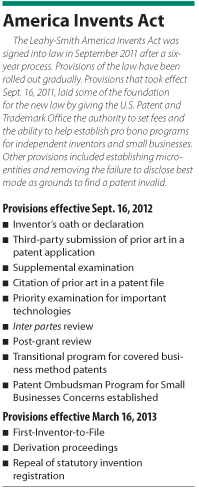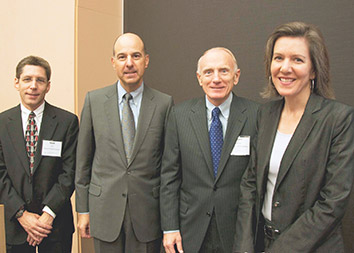Subscriber Benefit
As a subscriber you can listen to articles at work, in the car, or while you work out. Subscribe NowQuietly on Sept. 16, more provisions of the Leahy-Smith America Invents Act took effect, opening the patent granting process that has operated in the dark for much of the past 176 years.
Now competitors, inventors and other third parties will be able to challenge the validity of a patent application through a pre-issuance procedure and challenge a standing patent through the post-grant review process.
These changes are why, in part, Mark Janis, director of the Center for Intellectual Property Research at the Indiana University Maurer School of Law, describes the new patent law as the most significant reform of the U.S. patent system since the 1836 Act which established the patent office and an application examination process.
The AIA was signed into law in September 2011 after a six-year process that brought opposing groups together to collaborate on rewriting what some saw as a broken patent system.
Provisions in the AIA are being rolled out gradually over the course of a couple of years. The elements that became effective in 2012 include the challenge procedures and the inventor’s oath. Next March will bring the biggest shift as the U.S. patent system switches from a first-to-invent system to a first-to-file system.
Transparency and objectivity
To mark the first anniversary of the new patent law, the Center for Intellectual Property Research held a one-day symposium on Sept. 14 to discuss particular provisions in the new law and try to assess what the AIA accomplished and what it omitted.
Keynote speaker Robert Armitage, senior vice president and general counsel at Eli Lilly and Co., called the AIA a “giant step forward.” He is credited with being a driving force behind the bill’s passage and with keeping the Silicon Valley companies and the pharmaceutical and biotech companies at the negotiating table during the legislative process.
In a 2012 article for the American Intellectual Property Law Association Quarterly Journal, Armitage summarized how the new law will change the patent system.
“Through a 130-page bill over the six-year legislative process, Congress transformed the U.S. patent system from one of non-transparency, subjectivity, unpredictability, and excessive complexity, to one that will operate with near-complete transparency, objectiveness, predictability and simplicity in the principles that govern patentability and patent validity,” he wrote.
Speaking before the patent conference, Armitage acknowledged the AIA as passed by Congress contains errors that need to be corrected. Conference panelists highlighted the lack of caps on damages, no research exemption and the growing bureaucracy of the patent office as areas of concern.
However, Armitage advised the audience of legal scholars, U.S. Patent and Trademark Office representatives and practicing attorneys to “think more broadly” beyond their own interests as they tackle these errors.
A lot of compromise went into crafting the bill, he said, and it would be a shame if that spirit of cooperation was not continued in the work to correct the new law.
Challenge process
Until 1999, when the patent office began publishing many patent applications 18 months after they were filed, the granting process was conducted out of the public eye. In fact, the only notification that an inventor was applying for a patent often came on the day the exclusive rights were actually issued.
Through the AIA provisions for pre-issuance procedure and post-grant review that took effect Sept. 16, the public’s ability to contribute to the examination process will be enhanced, Janis said.
In the pre-issuance process, challengers have a limited window to submit prior art or documents of other patents and inventions and offer explanations that raise questions about whether the patent application should be granted.
“I think most people are hopeful it’s going to provide a mechanism to increase the quality of patents issued by the U.S. patent office,” said Joshua Larsen, registered patent attorney and an associate in the intellectual property department at Barnes & Thornburg LLP. He explained the pre-issuance procedure is viewed as likely to decrease the frequency of invalid patents being granted.
Although he expects many will utilize the pre-issuance process, he expects others to hold back from challenging the application because the procedure is not as robust at litigation. The challenger can argue against the validity of the patent application but cannot respond once the applicant has answered the charges. A court proceeding, Larsen said, would provide the opportunity to get the last word.
The success of the pre-issuance procedure rests on how the patent office implements the provision, Janis said. There are concerns that large, well-funded companies could flood the patent office with a huge number of prior art and explanations that would essentially tie up the entire patent system for a small upstart company.
Anticipating this possible pitfall, Janis noted the patent office has been careful about not obligating itself to considering all documents and materials submitted.
The post-grant review process will provide an alternative to litigation in challenging patents that have already been approved. Competitors can file a petition with the patent office, and the government agency has up to 18 months to consider it before issuing a ruling. Afterwards, the losing party can appeal straight to the federal circuit. Larsen expects the post-grant review process to have credibility, in part, because any appeal after the process will likely not be able to raise arguments that were not presented to the patent office.
Armitage touts this provision as potentially saving time and money. In particular, he pointed to Ariad Pharmaceuticals, Inc. v. Eli Lilly and Co., 598 F.3d 1336, 1341 (Fed. Cir. 2010), which took nearly a decade and included a couple of summary judgments and one loss at a jury trial.
The post-grant review, he said, could resolve cases like Ariad in months rather than years and reduce costs from millions of dollars to thousands.
First to file
Perhaps one of the more controversial parts of the bill, the first-to-file provision does not become effective until March 2013. This will bring a fundamental shift in the U.S. patent system where the priority is based on the first inventor to file for a patent rather than the first to invent the product.
Detractors say the first-to-invent system is more just and the first-to-file process makes inventors more vulnerable to having their ideas stolen. Janis noted the situation is less dramatic than the rhetoric would indicate. Already, the U.S. system is a mix of first to invent and first to file with many large corporations operating in a first-to-file mode.
The central argument for the provision is that it will help the domestic patent system come closer to being in harmony with other patent systems in foreign countries.
Closer harmonization will reduce costs for companies that operate globally, Larsen said. U.S. patent applications will be more aligned with applications from other countries so companies will not have to spend as much time and resources filing the different applications.
The assessment of whether or not the post-grant review system is beneficial will be done in a relatively short period of time but, Janis said, determining if changing to a first-to-file system was good or bad will take decades. Still, at this point, he sees more potential for a positive impact.
“I would be surprised if anybody can make a plausible argument that we destroyed our patent system because we adopted the evil European system,” Janis said.•
Please enable JavaScript to view this content.

